Do you have jaw pain? Jaw stiffness? Does your jaw lock up? Click uncomfortably?
Here are some heating, stretching, exercising and ice massage techniques that may help your jaw pain
Remember, always ask your healthcare provider before trying any home remedies to verify it is appropriate for your specific condition.
A Safe Heat/Stretch/Exercise/Ice Treatment for Jaw Pain
I believe the safest self-treatment for most jaw pain is to
1. Heat the upper back (trapezius muscles) for ten minutes to soften the neck, shoulders, and upper back muscles (all of which can affect the jaw).
2. Stretch the neck, shoulders, upper back, and jaw gently while the muscles are warm and pliable (as shown below).
3. Finish with two minutes of ice massage to the jaw to calm any inflammation that may have worsened with the heat and stretches. Partially wrap an ice cube with a towel (so you do not freeze the hand applying the ice), place the ice cube on the painful side of the jaw, and massage the outer muscles of the jaw with the ice in a circular fashion (Figure 7-1).

Figure 7‑1: Ice massage to the jaw.
Note: If both sides of the jaw are in pain, you can ice massage both sides at the same time. Place an ice cube in its own towel (so you do not freeze your hands while applying the ice), and massage the outer muscles of both jaw joints at the same time with the ice. Again, do not ice for more than two minutes.

Open And Closing The Jaw Straight
Most TMD involves the jaw popping and/or deviating out of its healthy hinge movement. Even if this is occurring without pain, it is a sign your biomechanics are off, and it needs to be addressed before it results in inflammation and pain.
Every time you brush your teeth (hopefully two to three times a day), open your jaw without allowing it to deviate from side to side; use your toothbrush as a guide (Figure 5-1). As you open your jaw, if it starts to deviate to either side, close it until the jaw is realigned correctly, then try opening it again without deviation. Keep repeating until the jaw is open as far as you can without pain. Then close the jaw. If, as you close, the jaw deviates to either side, open it slightly until it realigns and then try closing it again straight. This will help restore the jaw’s normal hinge movement.

Figure 5‑1: Using a toothbrush as a reference to open your jaw straight.

Let me go back to my riverbed and oxbow analogy that explains the jaw’s deviation during opening and closing.
If water continues to flow into the oxbow, that channel will deepen, potentially changing the water flow permanently. If more water flows into the riverbed than the oxbow, the oxbow may dry up and disappear. This is why you must practice opening and closing the jaw straight; doing so will help the jaw heal in proper alignment instead of forming an “oxbow.”
A healthy jaw should be able to open far enough to fit at least three fingers vertically between the front teeth (Figure 5-2 below).
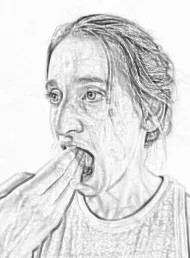
If you can’t fully open your jaw, you can use post-isometric stretches to increase the flexibility (see Chapter 6 - the next section).
SELF-MASSAGE, EXERCISES, AND STRETCHES FOR THE JAW
| THE JAW MUSCLES can benefit from exercises and stretches just like the rest of your muscles do. Here are some simple ones to try. |
Temporal Rub
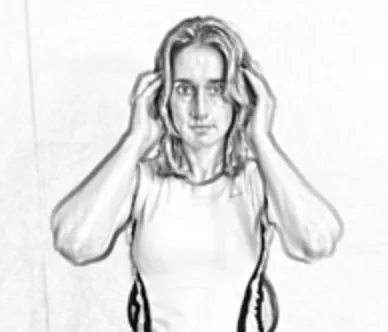
Figure 6‑1
Bring your fingers to your temples (the softer spots on the side of your head, just past your eyebrows; Figure 6-1). Press in circular motions to massage the temporal muscle. This massage often will help ease jaw pain.
Headache Pressure Points that may relieve jaw pain
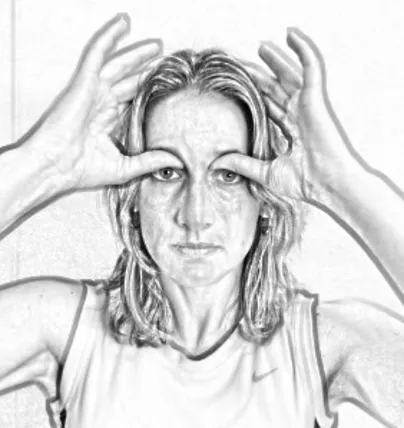
Figure 6‑2
If you have TMD, you are more vulnerable to headaches. If you have headaches, you may find tender spots along your eye sockets, both above and below your eyes. If you do, gently press on them for three breaths, giving yourself a type of acupressure treatment for head pain (Figure 6-2). Try to relax your whole body while exerting this gentle pressure. This may help relieve your headaches. Plus, pressing on the orbital bones may help mobilize the bones of your skull, which may ease tension in the skull that may be contributing to your jaw pain.
Sinus Pressure Points THAT MAY RELIEVE JAW PAIN

Figure 6‑3
You may also find tender spots along your cheeks. Using your fingertips, start by gently pressing on your face along the edge of your nose. If you find a tender spot, press for three breaths. Then move your fingers along your cheekbones. If you find another tender spot, press there for three breaths (Figure 6-3). Continue along your cheekbones until you reach your jaw muscles. This modified version of an acupressure treatment for sinus pain may also ease your jaw pain by increasing the mobility of the skull bones.
Cranial Press To Mobilize The Frontal And Cheekbones THAT MAY RELIEVE JAW PAIN

Figure 6‑4
TMD puts abnormal pressure on your skull bones, which can cause head, sinus, or jaw pain. To help relieve this pressure, try this cranial press technique. Place your right hand on the front right skull (temporalis) bone and your left hand on your cheekbone (zygomatic bone, also known as the malar bone). See Figure 6-4. Then press your hands toward each other; your right hand presses up and in while your left hand presses down and in.
This mobilizes the front bones (the zygomatic, maxillary, temporalis, and other skull bones), releasing some of the pressure caused by TMD. Often, this technique also often results in the drainage of maxillary and frontal sinuses.
Cranial Press To Mobilize The Occipital Bone THAT MAY RELIEVE JAW PAIN
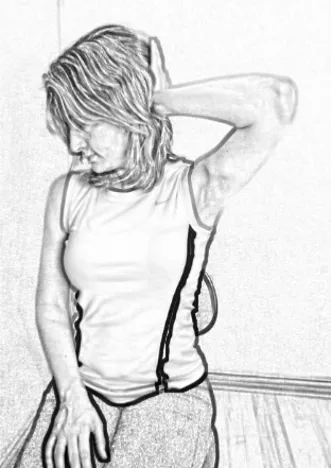
Figure 6‑5
TMD puts abnormal pressure on the base of the skull bone. To help relieve this pressure, try pressing up against the back of your head (Figure 6-5). This not only stretches and strengthens the muscles in the back of your neck, (which may be contributing to your jaw pain), but it also mobilizes the back skull bone (occipital bone).
This technique, when married with the temporal press and the frontal and maxillary press, often helps relieve jaw pain. It also helps headaches induced by barometric pressure changes (migraines specifically). A mobilized skull can better absorb the change of pressure, whereas a rigid skull results in the pressure change compressing the brain and its vessels.
Jaw Stretch THAT MAY RELIEVE JAW PAIN
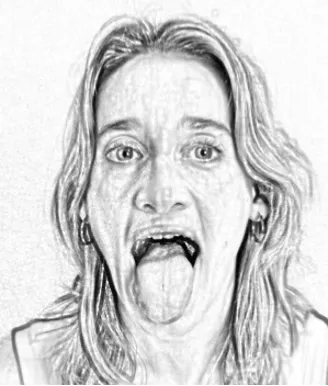
Figure 6‑6: "Lion's Pose" - an effective quick way to relax the deep muscles of the jaw
Stick your tongue out as far as you can to relax the pterygoid muscles inside your jaw, as shown in Figure 6-6. Extending your tongue is a simple yet powerful stretch. Try doing it every time you brush your teeth.
You can also contract and relax your facial muscles by making a variety of facial expressions. Making funny faces without using your fingers stretches every part of your face. If you can laugh, all the better!
Staring at a computer screen for long periods of time often results in a lack of facial movement, causing muscle weakness, which makes the skin on your face sag or wrinkle. Keep your skin looking more alive, youthful, and flexible by mindfully exercising the muscles in your face, too!
Post-Isometric Stretches For The Jaw THAT MAY RELIEVE JAW PAIN
To do a post-isometric stretch on your jaw, you can use tongue depressors. Stack as many as you can horizontally between your teeth. See Figure 6-7. Then bite down for an isometric contraction for three breaths.
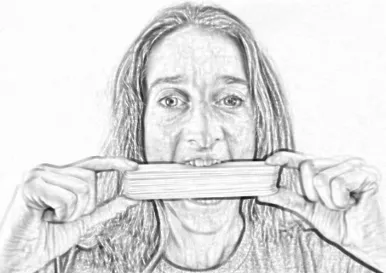
Figure 6‑7: using tongue depressors to bite against (isometric contraction)
When you relax, you should be able to open your jaw a little bit farther as the muscles relax after the contraction. If your mouth opens farther, try slipping in another tongue depressor and repeat (bite down, relax, open, and slide another tongue depressor in). Repeat a total of three (but not more than five times). Never strain your jaw open because it can cause further injury. Only open the jaw further if comfortable to do so.
Shoulder Rolls THAT MAY RELIEVE JAW PAIN
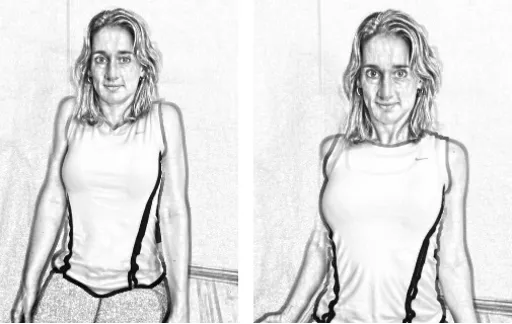
Figure 6‑8: relaxing the shoulders helps you relax your jaw
To loosen your anterior neck, upper back, and shoulder muscles, raise your shoulders to your ears and then roll them as far back as they will roll and as far down as they will go away from your ears (Figure 6-8). Allow them to move forward and rise back up to complete the circle. Slowly repeat this rotation five times. This stretch can be done while sitting or standing.
Breathe in as you raise your shoulders up, and breathe out as you roll them back and down. This way, you will combine stretching with a calming breath, which helps calm the mind (an important activity to do throughout a stressful workday, which can cause jaw tension). Remember, stress is the cause of all “dis-ease” that leads to disease, so find ways like this to relax, rejuvenate, and heal throughout the day.
Remember, after heating, stretching and exercising the jaw, ice massage for a minute or two to calm the jaw back down, as these stretches and exercises can irritate the structures of the jaw.

To learn more about how we treat here at Drummond Chiropractic, CLICK HERE.
To go back to our home page, CLICK HERE.
For More Information Check Out Dr. Karin's Books
You do not have to suffer
with jaw pain, clicking or locking.
We can help!
Why Wait? Click HERE to schedule!
Drummond Chiropractic, LLC
Your Bloomington Downtown Jaw Pain Specialists
565 N Walnut St
Bloomington, IN 47404
(812) 336 -2423



